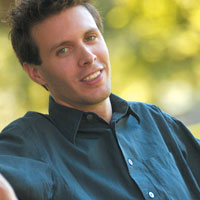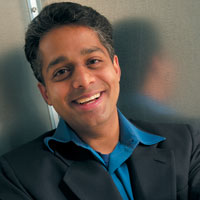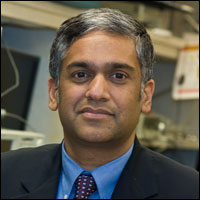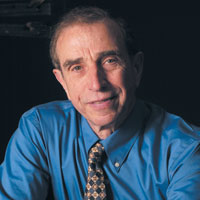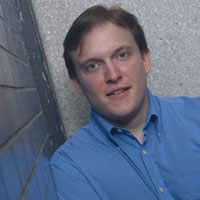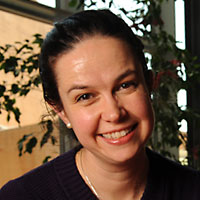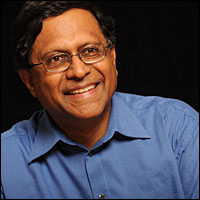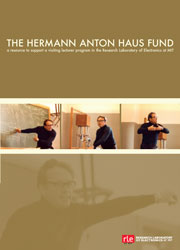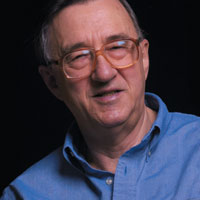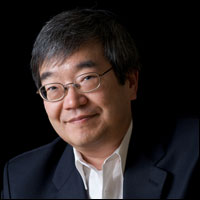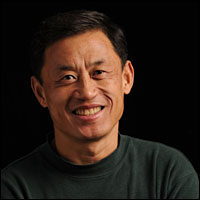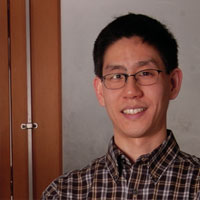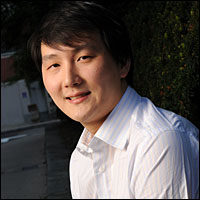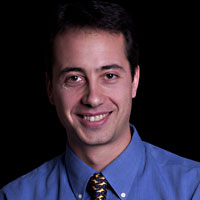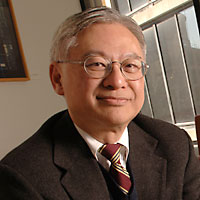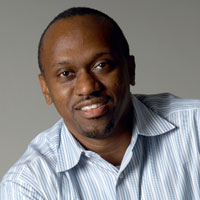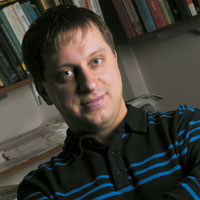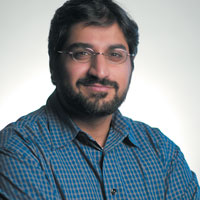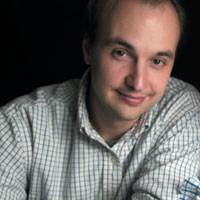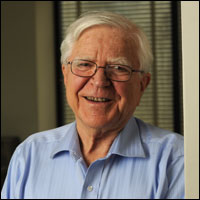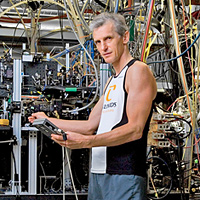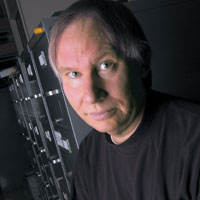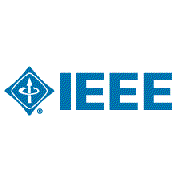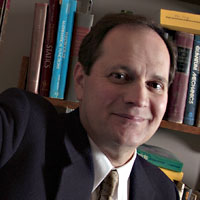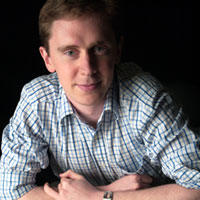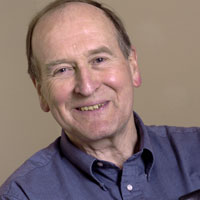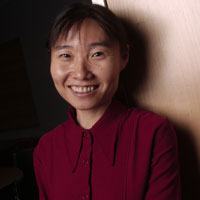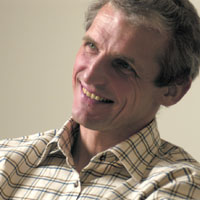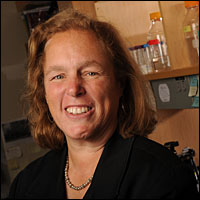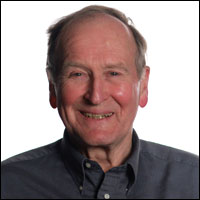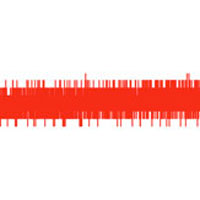RLE News
Perfect communication with imperfect chips
Error-correcting codes discovered at MIT can still guarantee reliable communication, even in cellphones with failure-prone low-power chips. «more» Related Links: Perfect communication with imperfect chips Professor Vivek K Goyal RLE Signal Transformation…
Sun-free photovoltaics
Materials engineered to give off precisely tuned wavelengths of light when heated are key to new high-efficiency generating system. «more» Related Links: Sun-free photovoltaics Prof. Marin Soljacic ab initio Physics Group
MIT part of $18.5 million effort to create mind-machine interface
New multi-institution center will work on robotic interaction with nervous system «more» Related Links: MIT part of $18.5 million effort to create mind-machine interface Professor Joel Voldman RLE Biological Microtechnology and BioMEMS Group
While you’re up, print me a solar cell
New MIT-developed materials make it possible to produce photovoltaic cells on paper or fabric, nearly as simply as printing a document. «more» Related Links: While you’re up, print me a solar cell Prof. Vladimir Bulovic Organic and Nanostructured…
The future of chip manufacturing
MIT researchers show how to make e‑beam lithography, commonly used to prototype computer chips, more practical as a mass-production technique.«more» Related Links: The future of chip manufacturing Professor Karl K. Berggren Professor Henry I. Smith RLE…
MIT faculty selected to attend NAE’s Frontiers of Engineering
RLE’s Rahul Sarpeshkar is one of three MIT faculty selected to attend NAE’s 17th Annual U.S. Frontiers of Engineering symposium in September at Google headquarters in Mountain View, California.«more» Related Links: MIT faculty selected to attend NAE’s…
Chandrakasan named head of electrical engineering and computer science
Anantha P. Chandrakasan, the Joseph F. and Nancy P. Keithley Professor of Electrical Engineering, has been named the next head of the Department of Electrical Engineering and Computer Science (EECS). He will assume the new role beginning July 1. «more»…
‘Artificial leaf’ moves closer to reality
MIT researchers develop a device that combines a solar cell with a catalyst to split water molecules and generate energy. «more» Related Links: ‘Artificial leaf’ moves closer to reality Prof. Vladimir Bulovic Organic and Nanostructured Electronics (ONE…
Spinning new materials in a thread
Researchers at MIT have succeeded in making a fine thread that functions as a diode, a device at the heart of modern electronics. This feat — made possible by a new approach to a type of fiber manufacturing known as fiber drawing — could open up possibilities for…
Jonathan Perry, John Sun and Da Wang named recipients of 2011 Claude E. Shannon Research Assistantships
The Research Laboratory of Electronics (RLE) at the Massachusetts Institute of Technology (MIT) announces that 2011 Claude E. Shannon Research Assistantships are being awarded to Mr. Jonathan Perry, Mr. John Sun, and Mr. Da Wang, all of whom are doctoral students in…
RLE Staff Members Mary Markel Murphy and Monica Pegis named recipients of the 2011 MIT Infinite Mile Award
The Office of the Provost and the Office of the Vice President and Dean for Research announced on Tuesday, May 3, 2011 that Ms. Mary Markel Murphy, RLE’s Assistant Director for Administration and Human Resources and Ms. Monica Pegis, Administrative Assistant II to…
M+Vision announces Fellowship finalists
Groundbreaking international biomedical imaging consortium convenes 24 finalists for elite fellowship. «more» Related Links: M+Visión announces Fellowship finalists Madrid–MIT M+Visión Consortium Professor Martha Gray Professor Elfar…
Oppenheim the Unorthodox
Alan Oppenheim ’59, SM ’61, ScD ’64, who literally wrote the book on digital signal processing, encourages far-out thinking that gets concrete results. «more» Related Links: Oppenheim the Unorthodox Professor Alan V. Oppenheim RLE Digital Signal…
“Excited About Excitons” wins DOE contest
RLE’s Center for Excitonics wins “Life at the Frontiers of Energy Research” Video Contest for outstanding portrayal of young scientists. «more» Related Links: Excited About Excitoncs Video More information about the contest Professor Marc A. Baldo RLE…
Turning windows into powerplants
If a new development from labs at MIT pans out as expected, someday the entire surface area of a building’s windows could be used to generate electricity — without interfering with the ability to see through them. «more» Related Links: Turning windows…
The bouncing gas
Clouds of gases that bounce off each other could help physicists model the behavior of high-temperature superconductors and other unusual materials. «more» Related Links: The bouncing gas Professor Martin W. Zwierlein RLE Ultracold Quantum Gases Group…
Secure, synchronized, social TV
Secure, synchronized, social TV: A technique called network coding could protect users’ privacy and providers’ content while making communications networks more efficient. «more» Related Links: Secure Synchronized, social TV Professor Muriel Medard RLE…
Mr. Lih Feng Cheow, Mr. Shanqing Cai and Dr. Faisal M. Kashif Named Recipents of the 2011 Helen Carr Peake Research Prizes
The winners of the 2011 Helen Carr Peake Prizes are Mr. Lih Feng Cheow, a doctoral student in Electrical Engineering and Computer Science; Mr. Shanqing Cai, a doctoral student in the Harvard-MIT Program in Speech and Hearing Bioscience and Technology; and Dr. Faisal…
Verghese is named one of the 2011 MacVicar Fellows for excellence in teaching
Four professors, including RLE’s George Verghese, have been named 2011 MacVicar Faculty Fellows as MIT celebrates the program’s twentieth year recognizing outstanding undergraduate teaching. «more» Related Links: Verghese named 2011 MacVicar Faculty…
MLK Leadership Awards honor three individuals, one program
Three MIT community members and one MIT organization have been named recipients of Dr. Martin Luther King Jr. Leadership Awards for 2011 in recognition of their service to the Institute and beyond. RLE’s Cheryl Charles is one of those recipients. «more»…
Dr. Rod C. Alferness to deliver the 2011 Hermann Anton Haus Lecture: Lecture series honoring Haus brings eminent visitors to MIT
Dr. Rod C. Alferness of Bell Laboratories, Alcatel-Lucent will be delivering the 2011 Hermann Anton Haus Lecture Wednesday, April 20, 2011. The title of Dr. Alferness’s lecture is, “Optical Networks: Meeting the Challenging Demands of the Global Digital Community” A…
MIT and Government of Madrid launch M+Visión Consortium to accelerate biomedical imaging innovation
Massachusetts Institute of Technology (MIT) and the Community of Madrid (one of Spain’s 17 autonomous communities, which includes the capital city of Madrid) have announced a new joint initiative designed to advance Spanish leadership and innovation in biomedical…
Fibres get functional
New forms of advanced optical fibres featuring exotic glasses, carefully designed microstructures and cores that are either hollow, fluidic, semiconductor or piezoelectric are giving light guides a new lease of life, reports Duncan Graham-Rowe. «more»…
Donald Troxel, longtime EECS professor, dies at 76
Donald E. Troxel, an MIT alumnus who later spent 40 years at the Institute as an electrical engineering and computer science faculty member and principal investigator at the Research Laboratory of Electronics and Microsystems Technology Laboratories, died on Jan. 18.…
Fujimoto wins Carl Zeiss Research Award
James Fujimoto, a professor of electrical engineering, has been named the recipient of the Carl Zeiss Research Award. Presented in alternating years, the award honors special scientific achievements in basic research and application in the field of…
James G. Fujimoto Named the Recipient of the Carl Zeiss Research Award
MIT electrical engineering professor responsible for advances in biomedical optical imaging wins prestigious ZEISS award The Ernst Abbe Fund has announced that James G. Fujimoto, Professor of Electrical Engineering at MIT, is the recipient of the Carl Zeiss Research…
Graphene electrodes for organic solar cells
A promising approach for making solar cells that are inexpensive, lightweight and flexible is to use organic (that is, carbon-containing) compounds instead of expensive, highly purified silicon. But one stubborn problem has slowed the development of such cells.…
RLE Holiday Party 2010 Video
Scenes from the annual RLE Holiday Party 2010 Link to Video on MIT TechTV
New hope for terahertz
Terahertz rays — radiation between microwaves and infrared rays on the electromagnetic spectrum — are a promising means of detecting explosives, but they’ve proven hard to generate cost effectively. So far, solid-state lasers — the cheap, miniature type of laser found…
Five from MIT elected fellows of the American Physical Society including RLE Professor Isaac Chuang
Professor Isaac Chuang is among five MIT faculty members to be elected as fellows of the American Physical Society (APS), an organization dedicated to the advancement of physics. He has been elected for “his breadth and leadership in the field of quantum information…
Mehmet Fatih Yanik’s Research Group: High-throughput drug discovery technologies highlighted in The Economist
Mehmet Fatih Yanik and his research group have created a miniature production line to streamline the process of testing drugs on worms. Their system is able to isolate a worm, perform precise laser surgery on it in order to sever just one of its neurons, treat it with…
Tuning in to a new hearing mechanism: Findings from MIT scientists could lead to hearing aids that mimic the ear’s ability to focus on particular frequencies
More than 30 million Americans suffer from hearing loss, and about 6 million wear hearing aids. While those devices can boost the intensity of sounds coming into the ear, they are often ineffective in loud environments such as restaurants, where you need to pick out…
7 win presidential early career honors MIT has greatest number of recipients from a single institution
On Friday, Nov. 5, President Barack Obama named seven researchers from MIT as recipients of the Presidential Early Career Awards for Scientists and Engineers (PECASE), the highest honor bestowed by the U.S. government on science and engineering professionals in the…
Physicist Martin Zwierlein wins Packard Fellowship
MIT physicist Martin Zwierlein has won a 2010 David and Lucille Packard Fellowship — a five-year, unrestricted research grant totaling $875,000. Zwierlein, an assistant professor of physics, is one of 17 recipients of this year’s awards, which are among nation’s…
Nerve-cell regeneration quest is fast tracked: Microchip technology rapidly identifies compounds for regrowing nerves, in live animals
Engineers at MIT have now used a new microchip technology to rapidly test potential drugs on tiny worms called C. elegans, which are often used in studies of the nervous system. Using the new technology, associate professor Mehmet Fatih Yanik and his colleagues…
MIT Smart Fibers Take In And Send Out Sound
Whether you slap on whatever’s handy or put together a well-coordinated ensemble, your outfit makes some sort of fashion statement. But imagine wearing clothes that could, literally, speak for themselves. «more» Related Links: MIT Smart Fibers Take In…
Timothy Lu selected as one of Technology Review’s TR35
Timothy Lu has been named to Technology Review magazine’s annual list of the world’s top innovators under the age of 35. Selected from more than 300 nominees by a panel of expert judges and the editorial staff of Technology Review, the TR35 is an elite group of…
Martin Zwierlein a winner of DARPA’s 2010 Young Faculty Award
The Defense Advanced Research Projects Agency (DARPA) of the U.S. Department of Defense (DoD) has named Martin Zwierlein, an MIT assistant professor of physics, as one of 33 winners nationally of its annual Young Faculty Award (YFA) competition. The YFA program…
IEEE Council on EDA to Honor MIT’s Luca Daniel With Early Career Award
Luca Daniel, Emanuel E. Landsman associate professor of Electrical Engineering at Massachusetts Institute of Technology, has been chosen as this year’s recipient of the Early Career Award from the IEEE Council on Electronic Design Automation…
Superconducting nanowire photodetectors developed by Karl K. Berggren’s research group and Lincoln Laboratory named one of R&D Magazine’s R&D 100 Awards for 2010
Superconducting nanowire photodetectors developed jointly by Karl K. Berggren’s research group and collaborators at Lincoln Laboratory have been named R&D Magazine as one of its R&D 100 Awards for 2010. «more» Related Links: MIT technologies…
RNA reprogramming: New technique developed by Mehmet Fatih Yanik’s research group holds promise to revert cells to an immature state that can develop into any cell type
In recent years, scientists have shown that they can reprogram human skin cells to an immature state that allows the cells to become any type of cell. This ability, known as pluripotency, holds the promise of treating disease. Now, for the first time, Mehmet Fatih…
High-thoughput biological imaging: new technology developed by Mehmet Fatih Yanik’s research group allows rapid study of living zebrafish larvae used to model human diseases
With the aim of enabling rapid, large-scale studies of living organisms, Mehmet Fatih Yanik’s research group in RLE has engineered a new imaging technique that can analyze zebrafish—a tiny fish with transparent embryos, or larvae, whose internal organs can be easily…
Fibers That Can Hear and Sing Could Power Electronic Textiles
The clothing of the future could be more than just fashion. MIT researchers are working to develop fibers that can hear and produce sound, and someday those could take the form of wearable electronics. «more» Related Links: Fibers That Can Hear and Sing…
New Fibers Can See, Hear, Speak
Clothing that can see, hear and even talk is being developed by scientists from the Massachusetts Institute of Technology. «more» Related Links: New Fibers Can See, Hear, Speak Professor Yoel Fink RLE Fibers@MIT
Fibers that can hear and sing: Yoel Fink’s research group creates revolutionary optical fibers that interact with their surroundings in new ways
In the August issue of Nature Materials, Yoel Fink’s research group in RLE announce a new milestone on the path to functional fibers: fibers that can detect and produce sound. Applications could include clothes that are themselves sensitive microphones, for capturing…
The Internet at 100X: Vincent Chan’s group advances revolutionary new network design
The heart of the Internet is a network of high-capacity optical fibers that spans continents. But while optical signals transmit information much more efficiently than electrical signals, they’re harder to control. The routers that direct traffic on the Internet…
Professors Vladimir Stojanovic, Mehmet Fatih Yanik, and Martin Zwierlein named 2010 recipients of the Jonathan Allen Junior Faculty Award
The Research Laboratory of Electronics (RLE) at the Massachusetts Institute of Technology (MIT) has named Vladimir Stojanovic and Mehmet Fatih Yanik, both Associate Professors of Electrical Engineering, and Martin Zwierlein, Assistant Professor of Physics, to receive…
Exposing collagen’s double life: discovery by Collin Stultz’s group shows that rigid structural protein can switch to a floppy shape that could lead to new treatments for heart disease
Collagen, a type of connective tissue that makes up about thirty percent of the human body, is a structural protein that serves as an important component of muscle, skin, bones and cartilage, and forms scar tissue when injuries heal. Recent work by Professor Collin…
Mysterious quantum forces unraveled: researchers in the Johnson and Joannopoulos groups find a way to calculate the effects of Casimir forces
Discovered in 1948, Casimir forces are complicated quantum forces that affect only objects that are very, very close together. Researchers in the groups of Professors Steven G. Johnson and John D. Joannopoulos have developed a powerful new tool for calculating the…
Natasa Blitvic and Shirley Xiaomeng Shi named Recipients of 2010 Claude E. Shannon Research Assistantships
The Research Laboratory of Electronics (RLE) at the Massachusetts Institute of Technology (MIT) announces that 2010 Claude E. Shannon Research Assistantships are being awarded to Ms. Natasa Blitvic and Ms. Shirley Xiaomeng Shi, both of whom are doctoral students in…
Toward more efficient wireless power delivery: Marin Soljacic’s research group shows that efficiency improves when multiple devices are charged at once
In 2007, Marin Soljacic’s research group in RLE announced that they had discovered a novel way of transmitting electricity without the use of wires. Now, the RLE researchers have demonstrated that the system’s efficiency at transmitting energy improves significantly…
Martin Zwierlein named ONR Young Investigator
The Navy’s Office of Naval Research (ONR) has named Martin Zwierlein, an assistant professor of physics in RLE, as one of its 17 new Young Investigators. «more» Related Links: Zwierlein named ONR Young Investigator Professor Martin W. Zwierlein RLE…
Yoshihisa Yamamoto to deliver the 2010 Hermann Anton Haus Lecture: Lecture series honoring Haus brings eminent visitors to MIT
Yoshihisa Yamamoto, Professor of Applied Physics and Electrical Engineering at Stanford and Professor of Quantum Information Science at the National Institute of Informatics will be delivering the 2010 Hermann Anton Haus Lecture Wednesday, April 21, 2010. The title of…
A system that’s worth its salt: New approach to water desalination could lead to small, portable units that could be sent to disaster sites or remote locations
A new approach to desalination being developed by researchers in Jongyoon Han’s RLE research group could lead to small, portable units that could be powered by solar cells or batteries and could deliver enough fresh water to supply the needs of a family or small…
Self-assembling computer chips
Molecules that arrange themselves into predictable patterns on silicon chips could lead to microprocessors with much smaller circuit elements. Researchers in Karl Berggren’s group are using electron-beam lithography sparingly, to create patterns of tiny posts on a…
Rajeev J. Ram named 2010 MacVicar Faculty Fellow
Rajeev J. Ram, Associate Director of RLE and Professor of Electrical Engineering, was named one of MIT’s four 2010 MacVicar Faculty Fellows today. The MacVicar Faculty Fellows Program was established in 1992 to honor the life and devotion to teaching excellence of…
Mechanical devices stamped on plastic
Microelectromechanical devices—tiny machines with moving parts—are everywhere these days: they monitor air pressure in car tires, register the gestures of video game players, and reflect light onto screens in movie theaters. RLE researchers in Vladimir Bulovic’s group…
Cell-inspired electronics: by mimicking cells, Sarpeshkar designs electronic circuits for ultra-low-power and biomedical applications
A single cell in the human body is approximately 10,000 times more energy-efficient than any nanoscale digital transistor, the fundamental building block of electronic chips. RLE’s Rahul Sarpeshkar is now applying architectural principles from these…
Rethinking networking: RLE researchers helped develop a theory that promised much more efficient data networks
About 10 years ago, electrical engineers suggested that bundles of data could be transmitted over a network more efficiently if, instead of passing unaltered from one end to the other, they were scrambled together along the way and unscrambled at the end. In 2003,…
The power of ‘random’: A ‘seemingly loopy’ technique that RLE researchers helped develop could dramatically improve the efficiency of communications networks
A radical new approach to the design of communications networks, called “network coding” promises to make Internet file sharing faster, streaming video more reliable, and cell-phone reception better—among other improvements. “Most networks right now are built roughly…
Explained: Gallager codes
In 1993, scientists achieved the maximum rate for data transmission—only to find they’d been scooped 30 years earlier by an MIT grad student. The startling performance of turbo codes mobilized researchers to try to explain why they worked so well. Within a few years,…
Qing Hu named AAAS fellow: among eight MIT researchers recognized for ‘scientifically or socially distinguished’ contributions
The American Association for the Advancement of Science (AAAS) has awarded the distinction of fellow to 531 members, including eight members of the MIT community. Qing Hu of RLE was cited for, “…outstanding contributions to the development of terahertz (THz)…
Qing Hu named 2010 IEEE fellow
Qing Hu, professor of electrical engineering and head of the THz Quantum Cascade Laser Group in the Research Laboratory of Electronics at MIT, is cited by the IEEE “for contributions to terahertz (THz) quantum-cascade lasers and applications.” «more»…
Fine-tuned laser
A wholly new approach to tuning a laser’s frequency brings us a step closer to airport scanners that can distinguish aspirin from explosives. In a paper appearing in the most recent issue of Nature Photonics, Qing Hu of RLE and his colleagues describe the first…
I’m a Runner: Wolfgang Ketterle, Ph.D.
The Nobel Prize-winning physicist from RLE, Wolfgang Ketterle, talks about his 2:50 marathon and how running helps him stay at the top of science. «more» Related Links: I’m a Runner: Wolfgang Ketterle, Ph.D. Professor Wolfgang Ketterle Center for…
Selling chip makers on optical computing
By designing chips that can be built using existing fabrication processes, RLE researchers in the Stojanovic and Ram groups show that computing with light isn’t so far fetched. «more» Related Links: Selling chip makers on optical computing Professor…
Turning heat to electricity: Hagelstein conceptualizes more efficient methods to harvest electrical power from heat waste
In everything from computer processor chips to car engines to electric powerplants, the need to get rid of excess heat creates a major source of inefficiency. But new research by Peter Hagelstein in RLE points the way to a technology that might make it possible to…
The 50 Best Inventions of 2009: the Electric Eye
The retinal implant under development in the RLE research group of John Wyatt has been named by TIME Magazine as one of its 50 best inventions of 2009. «more» Related Links: The 50 Best Inventions of 2009: the Electric Eye Professor John L. Wyatt, Jr.…
RLE Energy researchers find Obama an eager student
During a tour of RLE labs prior to his talk at Kresge Auditorium last Friday, President Barack Obama saw demonstrations of several clean-energy technologies being developed at MIT, including work in the RLE laboratories of Marc Baldo and Vladimir Bulovic showing…
Quantum computing may actually be useful: a quantum algorithm that solves systems of linear equations could point in a promising new direction
Until this week, the only common calculation where quantum computation promised exponential gains was the factoring of large numbers, which isn’t that useful outside cryptography. In a paper appearing today in Physical Review Letters, however, RLE researchers in Seth…
William F. Schreiber, 1925–2009
William F. Schreiber, Professor Emeritus at M.I.T, died suddenly at his home in Cambridge, MA. on Monday September 21, 2009, at the age of 84. From l959 until his retirement in l990, he was a faculty member at MIT as Professor of Electrical Engineering. He was…
Stimulating Sight
Led by electrical engineering professor John Wyatt, team develops retinal implant that could help restore useful level of vision to certain groups of blind people. Inspired by the success of cochlear implants that can restore hearing to some deaf people, researchers…
Magnetism observed in a gas for the first time
Led by Wolfgang Ketterle and David E. Pritchard, RLE physicists shed new light on magnetism in experiment with ultracold atoms. For the first time, RLE scientists in the Center for Ultracold Atoms have observed ferromagnetic behavior in an atomic gas, addressing a…
A fabric with vision: researchers create flexible lensless camera from web of light-detecting fibers
RLE researchers have developed light-detecting fibers that, when weaved into a web, act as a flexible camera. Fabric composed of these fibers could be joined to a computer that could provide information on a small display screen attached to a visor, providing the…
Louis D. Smullin, 1916–2009
Louis D. Smullin, head the Microwave Tube Laboratory and the Active Plasma Systems Group of the Research Laboratory of Electronics, and former head of the electrical engineering department who helped to create MIT’s Department of Electrical Engineering and Computer…
Drawing inspiration from nature to build a better radio: New radio chip mimics human ear, could enable universal radio
MIT engineers have built a fast, ultra-broadband, low-power radio chip, modeled on the human inner ear, that could enable wireless devices capable of receiving cell phone, Internet, radio and television signals. Rahul Sarpeshkar, associate professor of electrical…
Kaertner, Schindall selected as 2009 Fellows of IEEE Boston Section
Prof. Franz Kärtner is cited for his contributions to ultrafast optics while Prof. Joel Schindall is noted for his leadership in satellite communication and surveillance systems. « more » Related Links: IEEE Boston Section 2009 Fellows Professor Franz…
Albert T. McGurl named 2009 recipient of Infinite Mile Award
Albert T. McGurl has been named a 2009 recipient of the Infinite Mile Award for his service to the RLE research community. «more» Related Links: Albert T. McGurl named 2009 recipient of Infinite Mile Award Albert T. McGurl
A material for all seasons: RLE teams finding many uses for graphene, the newest form of carbon
In a blown-up image from a scanning tunneling microscope, it looks just like an endless sheet of chicken wire: a simple flat sheet made up of a lattice of hexagons. But this nanoscopic material called graphene, first generally acknowledged to exist just five years…
Five RLE Associate Professors Granted Tenure: Baldo, Berggren, Han, Voldman, and Zheng Tenured
The Research Laboratory of Electronics (RLE) at the Massachusetts Institute of Technology (MIT) announces that RLE Professors Marc A. Baldo, Karl K. Berggren, Jongyoon Han, Joel Voldman, and Lizhong Zheng, all appointed in the Department of Electrical Engineering and…
Six from MIT elected to National Academy of Sciences
John Joannopoulos, the Francis Wright David Professor of Physics and principal investigator in the RLE ab initio Physics group, is among six MIT faculty members newly elected to the National Academy of Sciences in recognition of their distinguished and continuing…
DOE to Establish Two Energy Frontier Research Centers at MIT: new $19M Center for Excitonics to be led by Marc A. Baldo of RLE
The Research Laboratory of Electronics (RLE) at the Massachusetts Institute of Technology (MIT) will be home to one of 46 new multi-million-dollar Energy Frontier Research Centers (EFRCs) announced today by the White House in conjunction with a speech delivered by…
DOE to establish two Energy Frontier Research Centers at MIT
The Massachusetts Institute of Technology will be home to two of 46 new multimillion-dollar Energy Frontier Research Centers (EFRCs) announced today by the White House, in conjunction with a speech delivered by President Barack Obama at the annual meeting of the…
Landsman gift aids electric energy-related engineering at MIT
A $4 million gift by Emanuel E. Landsman ’58, SM ’59, ScD ’66 and his wife, Sheila E. Landsman, to the MIT Laboratory for Electromagnetic and Electronic Systems (LEES) and the Department of Electrical Engineering and Computer Science (EECS) will provide a career…
The Laboratory for Electromagnetic and Electronic Systems (LEES) to be merged into the Research Laboratory of Electronics (RLE)
The Laboratory for Electromagnetic and Electronic Systems (LEES) will be merged into the Research Laboratory of Electronics (RLE) effective July 1, 2009 as part of a growing emphasis on energy-related research in RLE. Researchers affiliated with LEES are pioneers in…
Vladimir Bulovic named recipient of 2009 School of Engineering Bose Teaching Award
Vladimir Bulovic, the KDD Associate Professor of Communications and Technology in the Department of Electrical Engineering and Computer Science and principal investigator in the Research Laboratory of Electronics, RLE, is the 2009 winner of the Bose Award for…
It’s a fine line: New method could lead to narrower chip patterns
Researchers at MIT have found a novel method for etching extremely narrow lines on a microchip, using a material that can be switched from transparent to opaque, and vice versa, just by exposing it to certain wavelengths of light. «more» Related Links:…
Paul B. Corkum to deliver the 2009 Hermann Anton Haus Lecture: Lecture series honoring Haus brings eminent visitors to MIT
The Research Laboratory of Electronics (RLE) at the Massachusetts Institute of Technology (MIT) announces that Dr. Paul B. Corkum, Professor of Physics, Ottawa University and the National Research Council of Canada, will deliver the 2009 Hermann Anton Haus Lecture.…
Hansen Bow, Theodore Moallem, and Christopher Rohde Named Recipients of 2009 Peake Awards
Mr. Hansen Bow, a doctoral student in Electrical Engineering and Computer Science, has been awarded the Helen Carr Peake Research Assistantship for September 2009 through August 2010. Mr. Bow’s doctoral research is being done in the Research Laboratory of Electronics…
New material could lead to faster chips: Graphene may solve communications speed limit
New research findings by Prof. Jing Kong and colleagues could lead to microchips that operate at much higher speeds than is possible with today’s standard silicon chips, leading to cell phones and other communications systems that can transmit data much faster.…
Chandrakasan honored for semiconductor work
Anantha Chandrakasan, director of MIT’s Microsystems Technology Laboratories, today received the Semiconductor Industry Association (SIA) University Researcher Award. Chandrakasan, the Joseph F. and Nancy P. Keithley Professor of Electrical Engineering, was honored…
Bulovic named MacVicar faculty fellow
Vladimir Bulovic is one of the four newest MacVicar fellows. The program, now in its 18th year, is designed to create an elite group of MIT scholars committed to excellence in teaching and innovation in education. «more» Related Links: Four professors…
Good Vibrations: Sensory Communication Group aids the deaf by translating sound waves to vibrations
Lip reading is a critical means of communication for many deaf people, but it has a drawback: Certain consonants (for example, p and b) can be nearly impossible to distinguish by sight alone. «more» Related Links: Good Vibrations: Devices aid the deaf by…
Ketterle wins Humboldt Award
Wolfgang Ketterle has been elected the recipient of a Humboldt Research Award after having been nominated by the German scientist Theodor W. Hänsch. «more» Related Links: Ketterle wins award for lifetime achievements Professor Wolfgang Ketterle RLE…
Nine from MIT named AAAS fellows
Martha L. Gray, the Edward Hood Taplin Professor of Medical and Electrical Engineering, was named a fellow for “pioneering contributions to advancing orthopedic science, and for distinguished leadership in the design and implementation of scholarly programs that…
Boosting the power of solar cells: New research could lead to higher output, lower cost
New ways of squeezing out greater efficiency from solar photovoltaic cells are emerging from computer simulations and lab tests conducted by a team of physicists and engineers at MIT. Using computer modeling and a variety of advanced chip-manufacturing techniques,…
Henry I. Smith receives 2008 Nano 50 Award
Henry I. Smith of RLE was named a recipient of the 2008 Nano 50 Award from Nanotech Briefs, recognizing him as a leader and pioneer “with a significant background of accomplishments in advancing the state of the art in nanotechnology.” «more» Related…
Voldman wins Young Innovator Award at MicroTAS 2008
Joel Voldman at the Massachusetts Institute of Technology (MIT) was presented with the first Young Innovator Award, which is sponsored by the American Chemical Society (ACS) journal Analytical Chemistry, on October 13 at the MicroTAS 2008 conference in San Diego. This…
Unprecedented accuracy: RLE researchers achieve breakthrough in drift-free timing synchronization
MIT Research Laboratory of Electronics (RLE) engineers have achieved a dramatic breakthrough in drift-free synchronization based on mode-locked lasers. This achievement is an important milestone in transitioning mode-locked laser-based synchronization systems from the…
Professors Luca Daniel and Jing Kong named 2008 recipients of the Jonathan Allen Junior Faculty Award
The Research Laboratory of Electronics (RLE) at the Massachusetts Institute of Technology (MIT) has named Luca Daniel, Associate Professor of Electrical Engineering, and Jing Kong, Assistant Professor of Electrical Engineering, to receive 2008 Jonathan Allen Junior…



